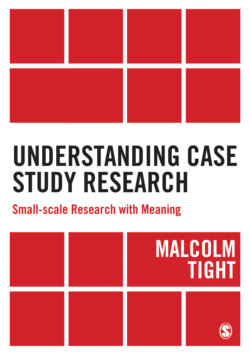Читать книгу Understanding Case Study Research - Malcolm Tight - Страница 12
На сайте Литреса книга снята с продажи.
The Origins and History of Case Study
ОглавлениеThe history of case study is a long and complicated matter: only a brief overview will be given here.
The development of case study as a research design both encompasses and illustrates the issues and critiques (these are discussed at greater length in Chapter 3) which it has had to deal with throughout its history. It also further demonstrates the diversity of usage to which the term case study (and analogous terms) has been put, and its application in a wide variety of disciplines (the subject of the next section and of Chapter 5).
Burgess (1927) offers an account of the early application of case study in American sociology. He notes that ‘The case-study method was first introduced into social science as a handmaiden to statistics’ (p. 114), with the latter long regarded – as it still is in many quarters today – as the most desirable way of undertaking research. In other words, case study was seen largely as a means for fleshing out and providing detailed illustration or exemplification to complement quantitative analyses, rather than as an alternative to them.
Burgess considered that ‘the actual introduction of the case-study as a method of sociological field research was made by Thomas and Znaniecki in The Polish Peasant in Europe and America’ (p. 116), which was first published in 1918 (see also Adelman 2015). This places case study (at least in its sociological context) as being about a century old. Unsurprisingly, then, Burgess, writing when case study was less than a decade old, concludes that ‘it is apparent that case-study as a method in sociology is still in its infancy’ (p. 117). Others, however, date the origin of case study research as rather earlier, with Scholz and Tietje (2002, p. 4) referencing the work of the French sociologist Le Play in 1855, adding more than half a century to Burgess’s reckoning.
Writing nearly 20 years after Burgess, Symonds (1945) reports on what was then recent work on the use of case study, in particular with respect to personality research. It is apparent from his argument and conclusion how important, despite the greater development and acceptance of the method, statistics and ‘objectivity’ remained:
[M]uch remains to be done to improve its methodology so that case materials may be amassed and treated in a manner that includes, on the one hand, objective appraisal and statistical integrity and that, on the other hand, never loses sight of the integrated, dynamic, holistic picture of human personality which the case study approach to research uniquely may give. (p. 357)
To survive alongside more ‘scientific’ methods, particularly statistics – with which it was constantly compared – case study had to be carried out in a suitably rigorous fashion (Burgess 1941; Cottrell 1941; Maxfield 1930; Stouffer 1941). From its beginnings, therefore, a great deal of attention has always been given to trying to devise common standards or approaches to case study.
Thus, Foreman (1948) sought to develop a theory of case studies. He argued that case studies use three sorts of data – personal documents, participant observation and third-person reports (a rather partial listing to the modern eye) – and that they may be used in five ways in sociological research: ‘They may serve purposes of: (1) illustration; (2) concept and hypothesis development; (3) hypothesis testing; (4) prediction or postdiction; (5) methodological testing or refinement’ (p. 410). He goes on to consider the adequacy of case records and their interpretation, how this may be judged, and the thorny issue of generalisation.
In the 1950s, however, case study became less popular for a period in the social sciences. As Platt (1992) notes, in her analysis of the history of case study in American methodological thought:
The term ‘case study’ has played a variety of roles, changing over time, in American methodological discussion… Its use has often been imprecise, carrying ideological connotations rather than analytical denonation. (p. 17)
She associates the post-war decline in the popularity of case study with a variety of other factors as well, including continuing concern with the issues of generalisation and prediction, problems with the articulation of case study analysis, and increased competition from the development of more sophisticated quantitative techniques and associated databases (an area in which American social science led the world).
Case study research began to make a comeback in the late 1960s and 1970s (Simons 1980, 2009), as qualitative techniques assumed a greater importance and popularity, particularly outside North America:
In the last 25 years the shift away from quantification and large scale survey methods in the social sciences, alongside the increasing attention being given to language and meaning in constructing identity and social relations, has seen a significant revival in case study methods. This has led to a range of reappraisals of the method, and an increased emphasis upon lived experience, the life-story and the biographical/autobiographical in social research. (David 2006, p. xxxix)
The increased development and diversification of qualitative methods (e.g. Denzin and Lincoln 2005a) both helped to build up the contemporary popularity of case study as a research design and led to its mistaken identification in some quarters as solely a qualitative approach. Its scale and accessibility as a research design resulted in its increasing usage by the growing numbers of final-year undergraduates, postgraduates and small-scale researchers in the social sciences and beyond.
